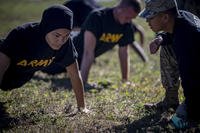The Selective Service System, otherwise known as the military draft or conscription, requires almost all male U.S. citizens and immigrants, ages 18 through 25, to register with the government.
You may have seen the question, "Have you registered for the selective service" on applications for jobs, driver's licenses, student aid and more.
But could you actually get called up into the military? Here's everything you need to know about the draft.
Related: 6 Reasons You Probably Won't Be Conscripted, Even if We Bring Back the Draft
Military Draft 2023
Will there be a military draft in 2023? Probably not. While world events such as the war in Ukraine and an increasing U.S. presence in Poland continue to evolve, there has been no indication that a military draft will take place in 2023.
Just What Is the Draft, and Why Must You Register?
The draft is officially known as the selective service. The selective service is a government bureau separate from the Defense Department whose mission statement is: "To register men and maintain a system that, when authorized by the President and Congress, rapidly provides personnel in a fair and equitable manner while managing an alternative service program for conscientious objectors."
Basically, this means that if we ever have a national emergency or war that the all-volunteer military can't adequately support, Congress and the president can reinstate the draft and force male citizens to serve in the military.
While women have not been excluded from combat service since 2013, they currently are not required to register for the draft. The law as it's written now refers specifically to "male persons" in stating who must register and who would be drafted. For women to be required to register with the selective service, Congress would have to change the law.
What If You Don't Register for the Draft?
Legally, you could be in a lot of trouble if you don't register: It's a felony. However, no one has been prosecuted for the crime since 1986. But that doesn't mean you won't have problems.
If you fail to register for the draft by the time you turn 26, you are no longer able to do so. Then, if you apply for any government benefits at any time after that, you quite possibly will be denied. No student aid, government job, etc.
Government statistics suggest that more than 1 million men have been denied some government benefits because they weren't registered for the draft. An appeal to get those benefits can be costly and time-consuming.
In 2017, the Selective Service System turned over nearly 200,000 names and addresses of people who had failed to register for the draft to the Department of Justice for computer matching.
Related: Learn about military pay
How to Register for Selective Service
Of course, they make it easy to register. Like the old Uncle Sam poster says, "They Want YOU!"
You can register online, at the post office and many high schools, when you get your driver's license or by returning the card that comes in the mail around your 18th birthday.
The law says men must register with the selective service within 30 days of turning 18.
Several groups are exempt from registering, such as those currently on active duty, some disabled persons and those who are incarcerated. Conscientious objectors are required to register. A conscientious objector is one who is opposed to serving in the armed forces and/or bearing arms on the grounds of moral or religious principles.
If you served on active duty and were discharged before your 26th birthday, you still have to register.
How Would the Draft Work if Implemented?
If it is ever needed and implemented, a present-day draft would have similarities to that of the Vietnam War. Here's how it would work.
The Selective Service System says it most likely would hold a draft lottery based on dates of birth. The number 1 would correspond to Jan. 1, 15 to Jan. 15, etc. Officials would draw numbers similar to drawing numbers for a lottery. If your birthdate is the first one drawn, you are the first to be drafted.
Normally, officials have a cutoff number based on the needs of the military. For example, during the 1969 draft lottery, men born between Jan. 1, 1944, and Dec, 31, 1950, were eligible to be drafted for the following year, 1970. Of the 366 possible birthdays in those years (leap years included), 195 birth dates were called for possible induction. That meant more than half the men born during those years were subject to being drafted. If your birthday wasn't one of the first 195 drawn, you were lucky -- you didn't have to go.
The second draft lottery, on July 1, 1970, was for men born in 1951. For that year 125 out of 365 possible birthdays were conscripted. The third Vietnam draft lottery was on Aug. 5, 1971, for men born in 1952; in that year, 95 birthdays were called up for compulsory service.
According to the selective service, if a draft were held today, those who are 20 years old -- or turning 20 during the year in which the numbers are drawn -- would be the first to go. Beginning Jan. 1 of the year an eligible male turns 21, he would drop into the second priority category, and men born the following year would move into the priority group one. Each succeeding year, a draft eligible man drops into the next lower priority group until he has reached his 26th birthday, at which time he is over the age of liability for the draft.
If Drafted, Must You Go to Combat?
It's important to know that even though someone is registered and his number is called, they may not be inducted automatically into the military. They may be eligible for a deferment; categories might include married persons, college students and family members of those killed in action.
You may also be excluded for medical or psychological reasons, may declare yourself to be a conscientious objector or may even be able to enlist in a specific branch or career field to avoid combat duty.
If you lack legal means to avoid the draft, you could just not show up for your ordered military service, you could "dodge" your service requirement. During the Vietnam War, approximately 570,000 people were classified as draft dodger, after not reporting for induction as ordered. Of those, 210,000 were charged formally with violating the draft, but only 3,250 were jailed. Of course, this was in the pre-computer and internet era; now, it's not quite so easy to be a fugitive from the feds. You could leave the country if drafted, like nearly 100,000 did during the Vietnam era. Those men were offered amnesty by President Gerald Ford in 1974 and pardoned by President Jimmy Carter in 1977.
Failing to register for the draft or join the military as directed is a felony punishable by a fine of up to $250,000 or a prison term of up to five years, or a combination of both. A felony conviction means you lose your right to vote and the right to own, possess and use a firearm, among other things.
Why Don't Women Have to Sign Up for the Draft?
The law doesn't require that women register for the draft. Although it's a subject of intense debate, and many other countries require women to complete national service or register for the draft, the U.S. does not.
In 2016, Congress came close to including women in the draft. House and Senate committees both approved a provision in the 2017 National Defense Authorization Act that would have made the change. But ultimately, lawmakers stripped out the provision and ordered a review of the Selective Service System instead.
Unless Congress changes the law, women are not permitted or required to register for the Selective Service System.
Interested in Joining the Military?
We can put you in touch with recruiters from the different military branches. Learn about the benefits of serving your country, paying for school, military career paths, and more: sign up now and hear from a recruiter near you.















